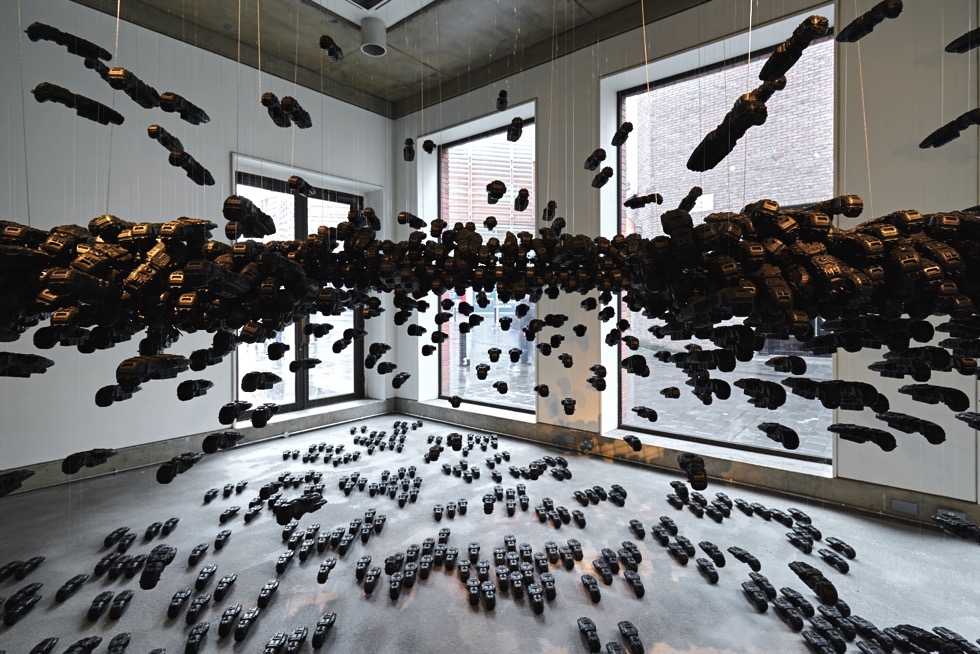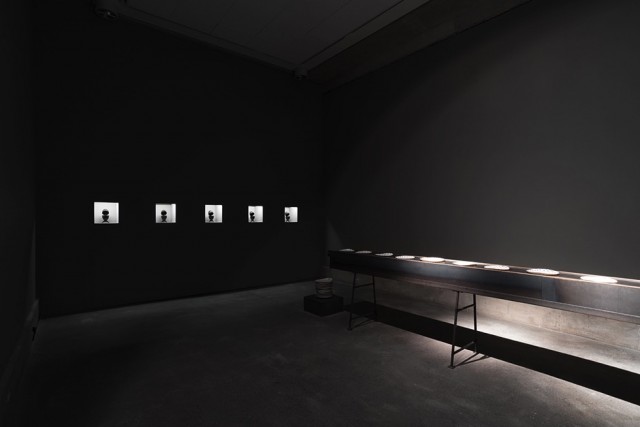Larissa Sansour: In The Future, They Ate From The Finest Porcelain – Reviewed

It’s your last chance to see Larissa Sansour’s scifi-flavoured solo exhibition at the Bluecoat today. Kyle Brown finds a confusing narrative, including spaceships, Palestinian soldiers, and archaeological discoveries…
It seems customary these days for art galleries to offer an information sheet summarising the exhibition, to be read before viewing the work. The Bluecoat’s current show, Palestinian artist Larissa Sansour’s In the Future, They Ate from the Finest Porcelain, is no exception. I was intrigued by the brief description, which describes the work as “drawing on themes of science fiction, archaeology and politics”; the latter two themes contained in a sci-fi context have the potential to be compelling. The gallery spaces are dimly lit; except for the natural daylight of Gallery Three, the walls are dark and the artworks have a colour scheme of earthy, sepia tones, with deep blacks and bright whites, and notably to a remarkably high finish. So far, so atmospheric.
The show has a very obvious focal point: a film in Gallery Two which inspires the exhibition’s title, and the rest of the artworks exist to pay homage that film and little else. The problem with this is it creates a stagnation throughout the gallery, which is filled with work that only exists to reference the film. In Gallery One, visitors will find Revisionist Production Line (2016): a stationary metal and wooden conveyor belt protruding from the wall, carrying white and blue porcelain plates. In Gallery Three, And They Covered the Sky Until It Was Black (2017) is a swarm of hand-sized, resin-cast spaceships. Intriguing signposts to the film, or weightless space filler? Continuing in this vein, Gallery One also includes Archaeology in Absentia (2016): five small, rather elegant, bronze sculptures fashioned after soviet nuclear missiles, presented within individual recesses in the wall. Each sculpture opens in the centre via a hinge, like a Fabergé egg, and each displays a different map co-ordinate; for example: 31° 34′ 52” N, and 35° 24′ 43” E.
The description for this piece alludes to a performance project, which is further displayed in the corridor. Along the wall is a map of Palestine, void of detail bar a number of red dots scattered around over its surface, and a series of black and white photographs depicting porcelain plates being buried in various locations. The performance, then, is the placement of these objects; each marked on the map, and memorialised by their co-ordinates in the nuclear, Fabergé-egg-like bombs. This all feels a bit like overkill and rather for its own sake, since the main drive behind this piece seems to be “converting the fiction of In the Future, They Ate from the Finest Porcelain into fact.”

In Gallery Two, you’ll find Sansour’s main event: In the Future, They Ate from the Finest Porcelain (2016); shown in a long, perfectly darkened room with benches. The film begins (every 30 minutes) with what reminds me of Middle-Eastern music, filling the room with a swell of loud bass. Tank-like spaceships take flight in a desert landscape; a powerful opening shot, which quickly becomes increasingly difficult to follow. Described by the artist on her website as a “fictional video essay” exploring “the role of myth in establishing history, fact and national identity”, the story follows a resistance group fabricating a history, laying claim to territories of a “counterfeit people” by burying seemingly valuable porcelain plates for future archaeological excavations to discover, consequently creating a nation. The protagonist, a “Narrative Terrorist” working on behalf of the resistance group, is driven by the memory of her younger sister, murdered callously as collateral damage by the opposing forces. Although this sounds like a potentially intriguing sci-fi drama, the overall composition lets it down.
Composed of HD live-action and CGI, in places In the Future, They Ate from the Finest Porcelain is visually stunning; and some of the dialogue is lyrical and captivating. However, it is hard work; 29 minutes of an over-complicated and tedious plot. With all of its complexities, it is an unrewarding challenge. My opinion is based on this: if the film was for commercial entertainment it would be considered pretentious or intentionally confusing; as a work of contemporary art in a public gallery, one could expect the film to evoke, stir, challenge the viewer in a number of ways, but being so overly convoluted it is difficult to find anything to come away with, besides mild frustration.
One redemptive piece is the exhibition’s other, earlier namesake, In The Future, They Ate from the Finest Porcelain 1–3 (2014), also in Gallery Two. This triptych of photo-montage prints predates the film by two years, and possibly indicates its early planning. Here are black and white photographs of real-world Palestinian soldiers and refugees; images spanning decades, imposed on a fictional desert landscape alongside the story’s protagonist. What marks these three images as more compelling than the rest of the exhibition is their visual strength and simplicity; and because of this, their ability to effectively communicate the story of a fictional nation based on factual events and people.
Sansour’s In the Future, They Ate from the Finest Porcelain isn’t a great exhibition. Besides alluding to vague concepts and ideas through complex analogies and fragmented dialogue, it is too self-contained. There is not enough of a connection between a work this complex and the viewer. “Sansour’s exhibition”, the information sheet rightly states, “suggests that by looking forwards and backwards, to scientific fact and mythic fiction, we may address an urgent present.” But as the only line of text connecting the exhibition to real life, perhaps this should have been expanded upon, as it feels, rather hopelessly, self-satisfying; as if the exhibition exists regardless of whether or not visitors particularly understand or enjoy the work, or even if it receives any visitors at all.
Kyle Brown
See Larissa Sansour: In the Future, They Ate from the Finest Porcelain at the Bluecoat, Liverpool, until 24 June 2017 — FREE
All images Larissa Sansour, In the Future, They Ate from the Finest Porcelain, Installation Shot at Bluecoat, 2017. Top image ® Rob Battersby 2017





